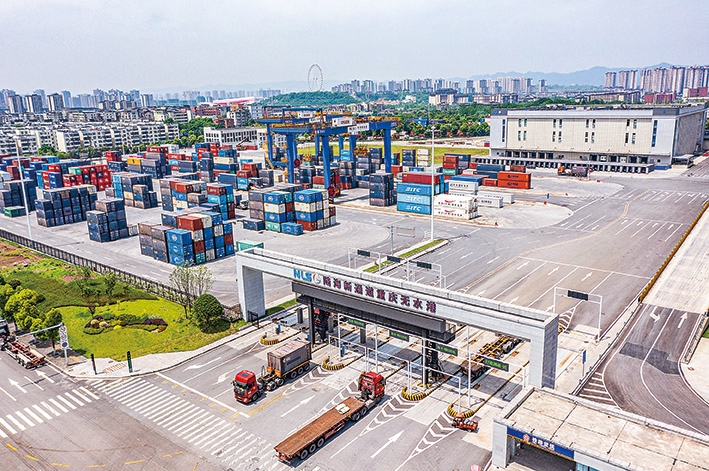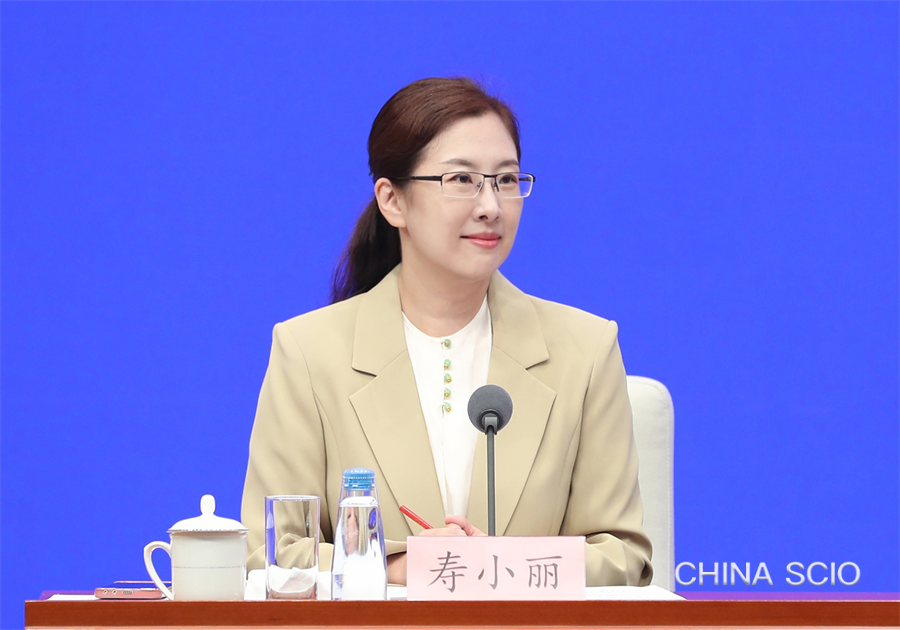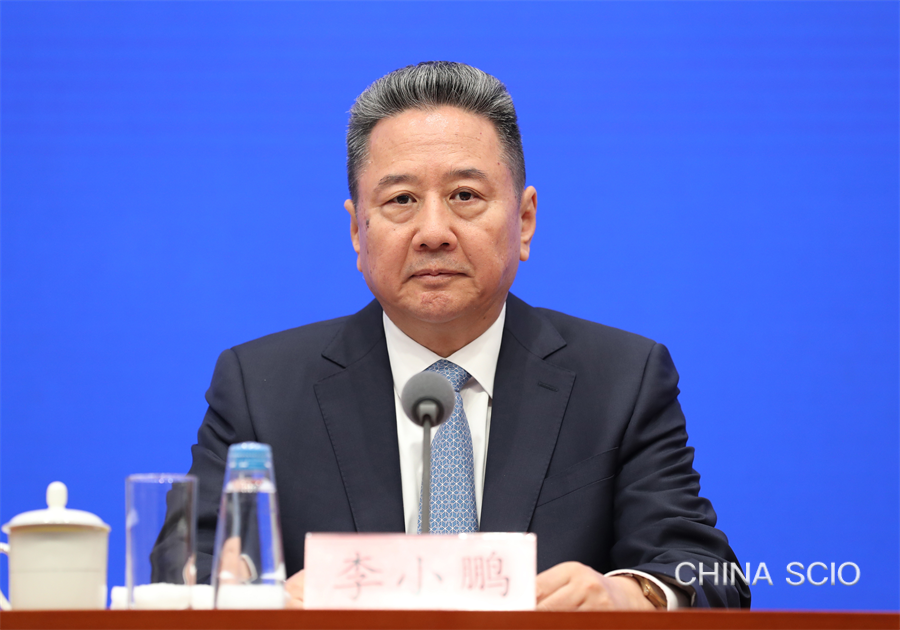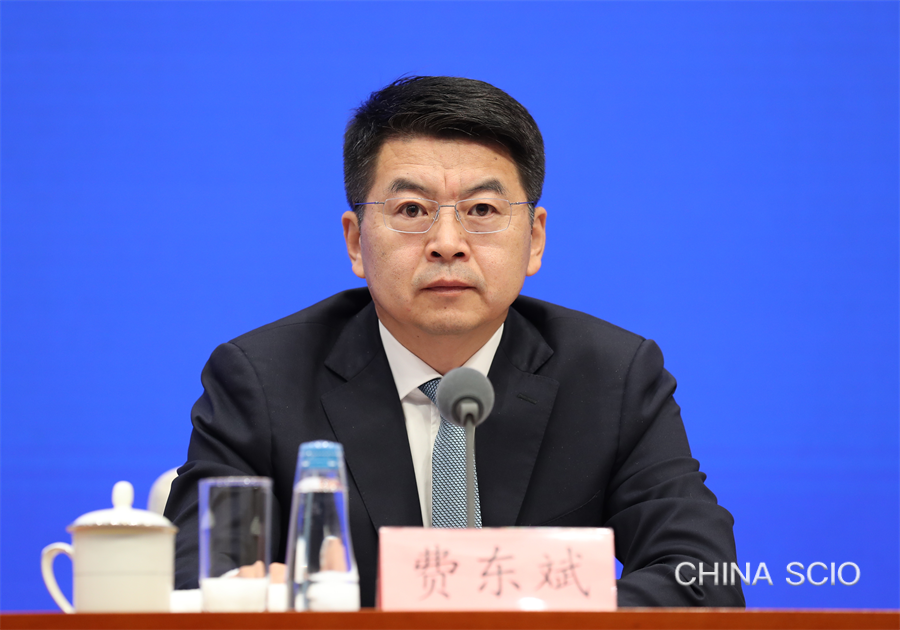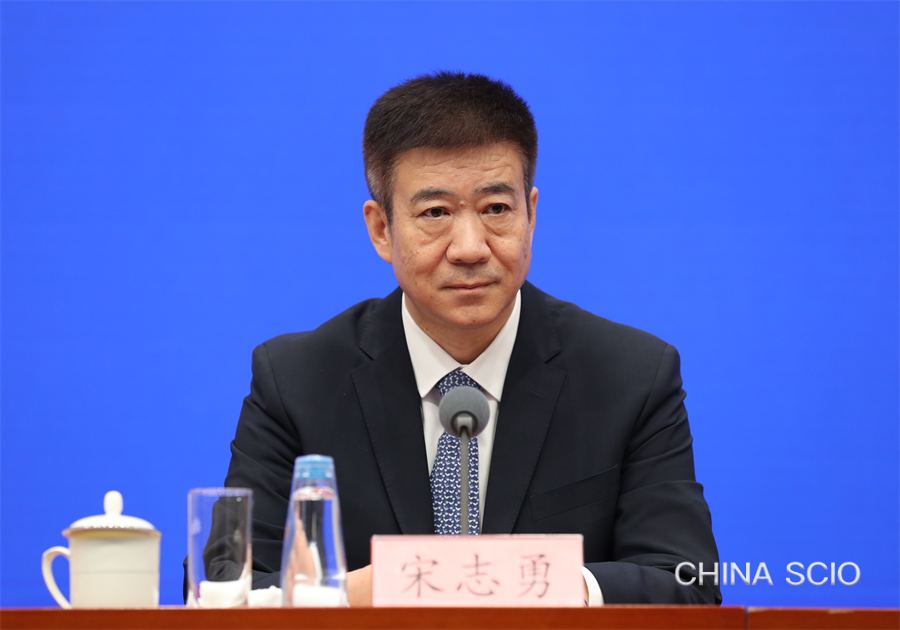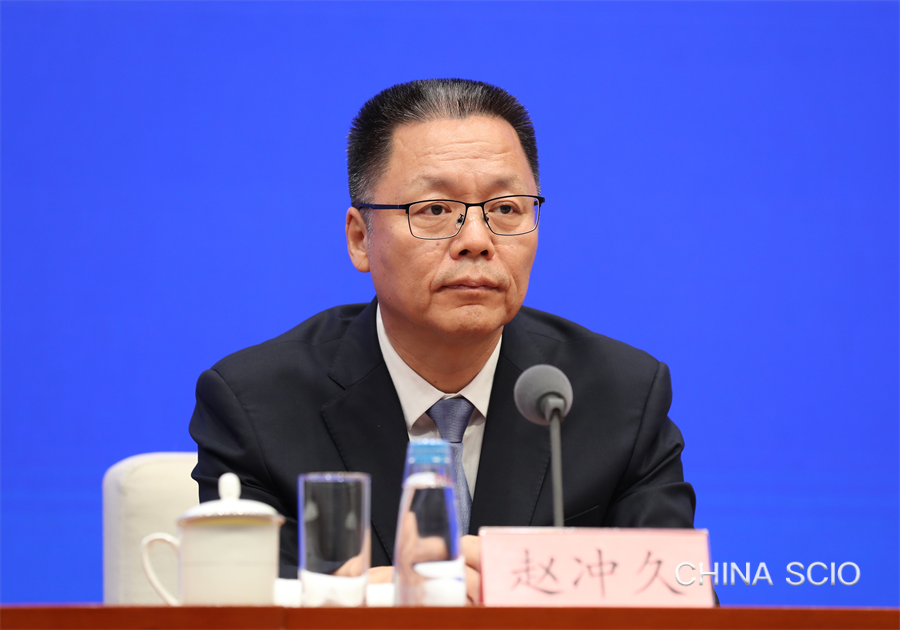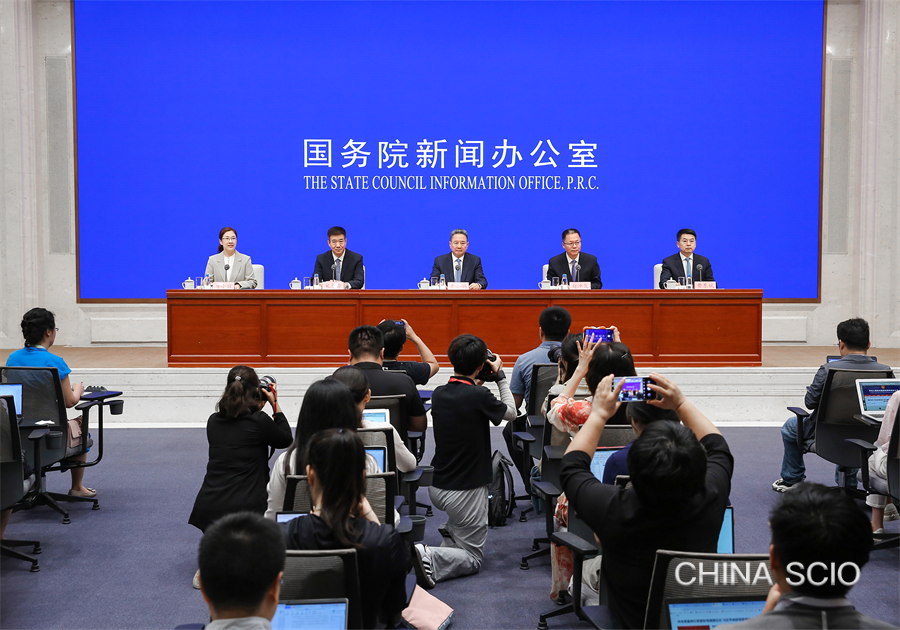Read in Chinese
Speakers:
Mr. Li Xiaopeng, minister of transport
Mr. Fei Dongbin, administrator of the National Railway Administration
Mr. Song Zhiyong, administrator of the Civil Aviation Administration of China
Mr. Zhao Chongjiu, director general of the State Post Bureau
Chairperson:
Ms. Shou Xiaoli, director general of the Press Bureau of the State Council Information Office (SCIO) and spokesperson of the SCIO
Date:
July 10, 2024
Shou Xiaoli:
Ladies and gentlemen, good morning. Welcome to this press conference held by the State Council Information Office (SCIO), as part of the series "Promoting High-Quality Development." Today, we have invited Mr. Li Xiaopeng, minister of transport, to brief you on relevant developments and answer your questions. Also present today are Mr. Zhao Chongjiu, director general of the State Post Bureau (SPB); Mr. Song Zhiyong, administrator of the Civil Aviation Administration of China (CAAC); and Mr. Fei Dongbin, administrator of the National Railway Administration.
Now, I'll give the floor to Mr. Li for his introduction.
Li Xiaopeng:
Ladies and gentlemen, friends from the media, good morning. I'm very pleased to meet you all here. I would like to express my gratitude for your long-term interest in, support, and help for, as well as supervision of China's transportation undertakings.
This year marks the 75th anniversary of the founding of the People's Republic of China. Over the past 75 years, China's transport sector has continued to grow. As General Secretary Xi Jinping pointed out, since the founding of New China, generation after generation of the Chinese people have worked in the spirit of opening roads through mountains and building bridges over rivers, and turned China into a country with vast transport infrastructure. Today, we are redoubling our efforts to build a country with great transport strength. Transport has become a frontier in China's modernization drive. This year is also the fifth year since the CPC Central Committee and the State Council issued the outline on building China's strength in transportation. In the past five years, we have carefully studied and implemented General Secretary Xi Jinping's major expositions on building China's strength in the transport sector, and continued to promote the high-quality development of transportation.
Over the past five years, our transportation infrastructure has been continuously improved. The total length of the comprehensive three-dimensional transport network exceeds 6 million kilometers, and the comprehensive east-west and north-south transport networks have become more complete.
Over the past five years, our passenger and freight transportation have continued to develop. Passenger travel has become more comfortable and convenient, and freight transport has become smoother and more efficient, moving toward the beautiful vision of enjoyable travel for people and smooth transportation of goods.
Over the past five years, our technological innovation has been continuously strengthened. Construction technology has leapt forward as a whole. Breakthroughs have been achieved in equipment research and development and the pace of smart transportation has accelerated. New technologies, new business forms and new models such as autonomous driving have flourished, and technological innovations in transportation have effectively promoted industrial upgrading.
Over the past five years, our green and low-carbon development has continued to improve. The transportation structure has been further optimized, and the efficient and intensive use of resources has been significantly improved. The green and low-carbon transformation of transportation has contributed to the construction of a Beautiful China.
Over the past five years, the big department system reform has continued to deepen. The comprehensive transportation governance capacity has been continuously improved, and the legal system, policy system and standards system have been further upgraded.
Over the past five years, our international cooperation has been continuously strengthened. We have continuously deepened bilateral and multilateral cooperation, promoted high-quality Belt and Road Initiative (BRI) cooperation, and continuously improved connectivity. We have signed more than 160 land, sea, air and mail-related agreements with more than 90 countries and regions.
Overall, in the five years since the issuance of the outline on building China's strength in transportation, our comprehensive strength in the transport sector has increased significantly, taking a big step toward the goals of satisfying people's needs, ensuring guarantees and being at the forefront of the world.
Next, we will comprehensively implement the guiding principles of the 20th CPC National Congress, the second plenary session of the 20th CPC Central Committee, and the upcoming third plenary session of the 20th CPC Central Committee, fully and faithfully apply the new development philosophy on all fronts, contribute to the creation of a new development pattern, and pursue progress while ensuring stability. We will strengthen workplace safety, do a good job in flood control, drought relief, and emergency management and rescue, deepen the reform of the comprehensive transportation system, promote cost reduction, quality improvement, and effectiveness of transportation and logistics, promote the large-scale renewal of equipment, expand effective investment, strengthen global transportation cooperation, serve high-quality BRI cooperation, work to accelerate the boosting of China's strength in transportation, strive to be a frontier of China's modernization drive, and provide more solid and powerful transportation service guarantees in building a great modern socialist country and advancing national rejuvenation.
That is all for my introduction. Next, my colleagues and I are willing to answer your questions. Thank you.
_ueditor_page_break_tag_
Shou Xiaoli:
Thank you, Mr. Li, for your introduction. We will now move to the Q&A session. Please identify the media outlet you represent before asking your question.
Economic Daily:
The fourth meeting of the Central Commission for Financial and Economic Affairs (CCFEA) called for the optimization of major transportation routes and corridors to unclog bottlenecks. In accelerating the boosting of China's strength in transportation, what progress has been made in this regard? What are your considerations going forward? Thank you.
Li Xiaopeng:
Thank you for your interest in the construction of major transportation routes and corridors. At present, the total length of China's comprehensive three-dimensional transport network has exceeded 6 million kilometers, as I mentioned. As part of this, the main framework of "six axes, seven corridors and eight trunk lines " has basically taken shape. The "six axes, seven corridors and eight trunk lines" are the main framework of the comprehensive three-dimensional transport network stated in the guidelines on developing a comprehensive transport network. The "six axes" refer to the main corridors between the four economic development poles of the Beijing-Tianjin-Hebei region, the Yangtze River Delta, the Guangdong-Hong Kong-Macao Greater Bay Area and the Chengdu-Chongqing Economic Circle, which are also the main transportation corridors in China. The "seven corridors" mainly refer to seven transport routes such as the western land-sea transport corridor. The "eight trunk lines" refer to eight routes such as the border passage. The main framework of "six axes, seven corridors and eight trunk lines" covers more than 80% of China's counties and serves about 90% of China's economy and population.
From a sectoral perspective, by the end of last year, the country's in-service railway network reached a total length of 159,000 kilometers, with more than 45,000 kilometers of high-speed railways. The nation's highway system extended to 5.4368 million kilometers, including 183,600 kilometers of expressways. Inland navigable waterways stretched for 128,200 kilometers, with 15,400 kilometers classified as Class III and above. The number of quay berths for production use amounted to 22,023, of which 2,878 were berths of 10,000-ton-class or above. In terms of civil aviation, there were 259 transport airports, of which 38 had an annual passenger throughput of 10 million or more, and 63 had a cargo and mail throughput of 10,000 tons or more.
In general, we have made remarkable progress in infrastructure development, especially in the construction of integrated, multidimensional transportation networks, particularly the main framework and trunk roads.
Though having achieved significant progress, there are still areas that require improvement. For example, there are weaknesses in the development of normal-speed railways. The capacity of inter-regional expressways as transport channels needs to be improved. Deficiencies exist in the construction of inland waterways and the connectivity of water transport systems. Moreover, comprehensive hubs need to gain greater influences.
In the next step, we will further accelerate the construction of the main framework consisting of six axes, seven corridors, and eight channels and build demonstration corridors. We will also further complement and strengthen the national comprehensive freight hub chain by advancing a series of major construction projects, including the railway freight network project, the national highway connectivity improvement project, and the inland waterway transport system connectivity project. In summary, we will expedite the elimination of bottlenecks to make new contributions to the smooth flow of the national economy. Thank you!
_ueditor_page_break_tag_
Jinan Times APP:
As civil aviation passengers, we are very concerned about flight punctuality. Could you please share what specific measures the civil aviation industry has taken to improve operational efficiency and ensure flight punctuality? Thank you.
Song Zhiyong:
Thank you for your question. Flight punctuality is a topic of great concern to passengers and a task we attach great importance to. Flight punctuality affects passengers' travel experience and reflects the overall efficiency and smoothness of civil aviation transportation organizations. It is an important indicator of high-quality development in civil aviation. The key to improving flight punctuality lies in enhancing the operational efficiency of civil aviation. In recent years, we have taken multiple measures and comprehensive policies to improve operational efficiency, including the following:
First, we have optimized airspace structures and increased airspace capacity. With the continuous release of dividends from national air traffic management reforms, the supply of airspace resources has continued to improve. By establishing major air corridors and optimizing airspace structures, we have increased flight handling capacity in high-traffic airspace, effectively alleviating the pressure caused by rapid flight growth. For example, in 2022, the Beijing-Guangzhou air corridor was opened. This major north-south air traffic artery, connecting China's Beijing-Tianjin-Hebei region and the Guangdong-Hong Kong-Macao Greater Bay Area, was expanded from a single pair of routes (one for each direction) to a dual pair of routes (two for each direction), increasing airspace capacity by nearly 40%. There are plans to open 10 such air corridors, with seven already completed and operational. The eighth, the Shanghai-Kunming air corridor, will be opened in September this year, providing airspace support for efficient flight operations. This corridor primarily aims to ease the air traffic jam along the east-west route linking Shanghai and Kunming.
Second, we have improved operational standards and enhanced the level of coordinated transportation. Airlines, airports, and the air traffic management authority are the three main entities in civil aviation operations. We have formulated targeted policies and measures on flight organization of airlines, ground support at airports, air traffic flow management, and evaluation methods for airport gate docking rates. To optimize operational standards, we raised specific requirements for reducing the minimum interval between aircraft operations, shortening ground taxing time, reducing runway occupancy time, and increasing the rate of aircraft docking near terminals. This year, we also issued measures on civil aviation collaborative operation management, establishing a three-tier collaborative system for civil aviation operations at national, regional and airport levels that integrates negotiated decision-making, joint implementation, and dynamic management, to continuously improve the efficiency of matching route capacity with flight traffic.
Third, we have promoted the application of new technologies to enhance operational efficiency. Civil aviation is a field where large numbers of new technologies emerge. In recent years, we have optimized and improved our operational methods by embracing new technologies. This has allowed us to continuously enhance safety and operational efficiency. For example, widely used Category II and III instrument landing systems, performance-based navigation, and in-flight head-up display s can enable aircraft to safely take off and land in low visibility conditions, significantly reducing weather-related disruptions. In the next step, during the construction of smart civil aviation, we will further enhance operational efficiency by promoting new technologies and models such as proximity landing and takeoff, the Point Merge System, and trajectory based operations.
Through these efforts, civil aviation has maintained a flight punctuality rate of above 80% for six consecutive years. In the first half of this year, despite a 13.4% year-on-year increase in flight volume, the flight punctuality rate reached 86.37%. We're currently in the thunderstorm season, which is the most stressful and challenging period of the year for ensuring reliable flight operations. Nevertheless, we have made preparations to maintain safe operations while minimizing weather-related disruptions. Our goal is to ensure smooth travel for all passengers. We also hope that everyone can provide more understanding and support for our work in civil aviation. Thank you.
_ueditor_page_break_tag_
CCTV:
We're aware that the large-scale renewal of transportation equipment is an important task for the transport authorities this year. Could you please tell us what deployments and plans the MOT has in this regard? Thank you.
Li Xiaopeng:
Thank you to the reporter from CCTV for your question. The large-scale renewal of transportation equipment is one of our key priorities this year. The promotion of a new round of consumer goods trade-ins and large-scale equipment upgrades is a significant initiative put forth by the CPC Central Committee and the State Council, with a focus on China's overall high-quality development. The large-scale renewal of transportation equipment plays a crucial role in achieving high-quality development. The effort will help stimulate investment, improve infrastructure and drive industrial upgrading. Additionally, it contributes to energy saving and carbon reduction goals while is also helping to lower logistics costs. Overall, it delivers both immediate and long-term benefits.
For the transportation industry, the scale of equipment is substantial. As of the end of last year, China possessed more than 20,000 railway locomotives, over 12 million operational vehicles, approximately 120,000 water transport vessels, and nearly 700,000 public and electric buses. Among these, a significant portion of the equipment needs updating, representing a considerable scale of renewal.
We are fully implementing the decisions and plans of the CPC Central Committee and the State Council. In collaboration with the National Development and Reform Commission, the Ministry of Finance, and other relevant departments, we have formulated an action plan. Moving forward, we plan to carry out actions in seven areas: first, accelerating the elimination and renewal of old diesel commercial vehicles; second, scrapping and renewing old commercial ships; third, replacing urban buses with electric ones; fourth, eliminating and renewing old locomotives; fifth, replacing old postal and courier equipment; sixth, upgrading and renovating logistics facilities and equipment; seventh, improving standards. These seven areas cover all fields and departments of transportation. We will strengthen leadership, coordinate cooperation, improve policies, and accelerate implementation. Thank you.
_ueditor_page_break_tag_
Hong Kong Bauhinia Magazine:
Recently, the Guangzhou-Foshan South Ring and the Foshan-Dongguan intercity railways officially opened, connecting with the Dongguan-Huizhou and Foshan-Zhaoqing intercity railways. Additionally, the Shenzhen-Zhongshan cross-sea passage was also put into operation. The "one-hour commuting circle" in the Guangdong-Hong Kong-Macao Greater Bay Area is rapidly taking shape. Could you please tell us what work the National Railway Administration has done to promote the "four-network integration of rail transit" and support development strategies for regions? What specific measures are being taken? Thank you.
Fei Dongbin:
Thank you for the question. The concept of integration of "the four networks" refers to the integration of trunk, intercity, suburban, and urban railways. It primarily focuses on the integration and connectivity of urban subway systems with intercity and suburban railways. As national-level strategies for regions are implemented, the demand for the integration of "the four networks" has increased. The CPC Central Committee and the State Council have made specific deployments in strategic plans such as the Outline for Building China's Strength in Transport and the Outline for National Comprehensive Transport Network. The main challenge in achieving this integration is the lack of unified systems, standards, and management practices between subways and railways. To address these issues, we are coordinating with relevant departments and provinces. We've selected the Guangdong-Hong Kong-Macao Greater Bay Area as a pilot region to vigorously promote this integration effort. Our aim is to create a rail transit integration development model with Chinese characteristics.
Since the beginning of this year, we have supported and guided the opening of the Guangzhou-Foshan South Ring and the Foshan-Dongguan intercity railways, achieving the connection of four intercity railways. These new lines have integrated with the existing Foshan-Zhaoqing and Dongguan-Huizhou intercity railways, enabling operations with a similar function to buses across the network. At the same time, we've established a special work team in collaboration with relevant departments of Guangdong province, related enterprises and public institutions, and industry associations. We have jointly formulated an implementation plan with Guangdong province to advance the integration of "the four networks" in the Guangdong-Hong Kong-Macao Greater Bay Area. We are currently accelerating the implementation of this plan and, on this basis, developing industry standards with Chinese characteristics to guide "four-network integration" initiatives across the country.
Next, building on the pilot project in the Guangdong-Hong Kong-Macao Greater Bay Area, we will coordinate the promotion of "four-network integration" on a larger scale, vigorously advancing regional integrated development to better serve the implementation of major national strategies. We will focus on connecting facilities, ensuring ticketing system interoperability, establishing mutual trust in security checks, sharing information, and coordinating management.
In terms of facility connectivity, we will concentrate on the interconnectivity needs of multiple operating entities and multi-level rail transit. We'll draw up technical standards for the connectivity of infrastructure, locomotives, passenger transport vehicles, traction power supply, and communication signals while also researching to build interconnectivity access rules.
In terms of ticketing system interoperability, we will establish relevant standards for system interoperability and payment compatibility. We'll develop an implementation plan for ticketing system interoperability projects and actively promote a "one-time ticket purchase, one-time payment" service model.
In terms of mutual trust in security checks, we will promote the coordination and mutual recognition of railway and subway security check standards. We'll also improve transfer conditions, upgrade and strengthen security check facilities and equipment, and further streamline security check processes.
Regarding information sharing, we will explore mechanisms and channels for open data sharing. We'll establish standards for data collection and data security management, as well as promote the open sharing of various types of information.
In terms of coordinated management, we aim to develop and refine relevant institutional measures. This includes improving licensing for railway transport infrastructure, vehicles, and driver qualifications. We'll also promote management interoperability between railways and subways in areas such as equipment utilization, operational organization, and personnel management.
Thank you.
_ueditor_page_break_tag_
China Transport News:
We all know that convenient and efficient postal and express services have become an indispensable part of people's lives. What measures have relevant departments taken to ensure smooth delivery services while solving the "last-kilometer" problem? How will you promote the high-quality development of the postal and express delivery industry in the future? Thank you.
Zhao Chongjiu:
Thank you for your questions. The postal and express delivery industry has become an important sector closely related to China's economic and social development and people's lives. It has developed rapidly in recent years. We know that in 2023, China's express delivery volume exceeded 132 billion parcels, and in the first half of this year, 80 billion parcels have been delivered, a 23% increase compared to the same period last year, continuing to show a trend of rapid growth.
The postal and express industry is becoming increasingly important in economic activities. This industry involves door-to-door logistics services, for which both trunk line transportation and terminal delivery are crucial. As you mentioned, solving the "last-kilometer" problem is a very important part of our work. Over the years, we have made a lot of efforts in this regard and achieved a series of very good results. Here I will briefly introduce the main features of our work.
First, an expanding network has provided more convenient services. The postal and express sector has actively developed a modern delivery service network system of "hubs + channels + networks." At the terminal end, various service methods such as home delivery, smart lockers and courier stations have been developed. This variety in terminal services has enriched the supply of courier services and better met the public's diverse needs. People's demands for courier services are becoming higher and more diverse, and the industry is actively exploring various methods in terminal services to better meet these needs.
Second, industrial integration has provided stronger support for the real economy. The express delivery industry supports modern commercial and trade circulation. The smooth flow of parcels has greatly boosted the circulation of goods and the development of the retail industry, promoting the rapid growth of sectors such as e-commerce livestreaming and cross-border e-commerce. We have also actively supported modern agriculture by implementing the "courier station in every village" project, building over 1,200 county-level public delivery service centers and more than 300,000 village-level integrated delivery logistics service stations. The courier network has become an important channel for transporting agricultural products from villages to cities and for transporting consumer goods from cities to villages. We have also supported advanced manufacturing by integrating courier services into production lines, directly connecting production, supply and sales, and injecting new vitality into the development of the real economy.
Third, stronger growth drivers have laid a more solid foundation for development. We have continued to spur industrial innovation through sci-tech innovations. Advanced technologies such as intelligent sorting and security screening systems have been widely adopted, and the express delivery industry has played an increasingly prominent leading role in the logistics sector. We have actively leveraged the advantages of the system of "larger government departments", fully utilizing multi-modal transport to achieve door-to-door, one-bill and one-ticket services. In addition, experiments in high-speed rail express delivery have proven useful, and air-express delivery capacity has continued to increase. We have also actively explored low-altitude logistics scenarios such as drone delivery. Unmanned vehicles, drones and unmanned warehouses have been widely used. Scientific and technological developments have continuously promoted the restructuring of logistics organization, driving industry progress.
Fourth, we have improved the quality of our work to provide more effective services for the people. We have focused on solving pressing difficulties and problems that concern the people most in the postal and express sector, constantly taking special rectification measures. Express services catering to cold chains have developed rapidly. We have also introduced special measures to end unjustified charges for courier services in rural areas, continuously improved the handling of complaints, and actively carried out the "Nuanfeng Campaign " to care for and support couriers. As a result, the sense of gain and happiness of people using postal services has significantly increased.
In the first half of 2024, the public satisfaction score for courier services reached over 83 points, increasing by 2 points compared to the same period last year, indicating greater public satisfaction.
Next, focusing on promoting high-quality development of the industry, we will continue to empower the industry through digitalization and the application of smart technologies, and foster and develop new quality productive forces in line with local conditions. We will apply digital and smart technologies to every step from collecting, transferring and transporting to delivering parcels, effectively boosting total factor productivity. We will strengthen the construction of the delivery service network, optimize the layout of delivery hubs in line with city cluster development, continuously advance the construction of a rural delivery logistics system, and improve the international delivery service network to enhance internal and external connectivity. We will continue to deepen industry collaboration, promote the integration of service chains with advanced manufacturing, and better serve economic development. We will continuously strengthen business entities, and actively create a sound environment in which enterprises under all forms of ownership can compete and grow on a level playing field. Thank you.
_ueditor_page_break_tag_
Nanfang Daily, Nanfang Plus:
With the low-altitude economy rapidly growing and low-altitude flights becoming increasingly common, how can the CAAC fulfill its industry management responsibilities and promote the development of this sector? Thank you.
Song Zhiyong:
Thanks for your question. China's low-altitude economy, based on traditional general aviation and the emerging unmanned aerial vehicles (UAVs) industry, has experienced robust growth in recent years. I'd like to share some data with you. Currently, the number of UAV companies holding valid Remotely Piloted Aircraft Systems (RPAS) Air Operator Certificates exceeds 14,000. Additionally, over 225,000 individuals hold UAV operator licenses. In the first half of this year, nearly 608,000 UAVs were newly registered, representing a 48% increase compared to the end of 2023. The cumulative flight time of UAVs reached 9.816 million hours, an increase of 134,000 hours over the same period last year. These figures clearly indicate that China's low-altitude economy is entering a new phase of rapid growth.
To foster the sound development of the low-altitude economy, the CAAC, as the industry's regulatory body, is committed to fulfilling its responsibilities by adopting a comprehensive approach to promote the innovative development of new types of UAVs while accelerating the transformation and upgrading of traditional general aviation. Building upon its efforts in strengthened top-level design and planning guidance, the CAAC has focused on the following five aspects:
First, strengthen airworthiness certification system and capacity building. We have worked on airworthiness certification of traditional piloted aircraft, optimized technical standards in the UAV sector, and explored and innovated the UAV airworthiness certification modes to better adapt to the airworthiness review requirements for the UAV research and development, design and production.
Second, optimize infrastructure construction standards. In response to the new demands for planning, layout and function of general airports in the development of the low-altitude economy, we've improved construction and operation standards for general airports, temporary taking-off and landing points, and vertical taking-off and landing sites. We've also guided local authorities in improving infrastructure planning and construction for UAV usage.
Third, promote the construction of low-altitude service and guarantee systems. We've expedited the implementation of airspace classification and management to fully utilize low-altitude airspace resources. In collaboration with local governments, we've made efforts to enhance the communication, navigation and surveillance capabilities of low-altitude UAVs in space, air and on land. We've also improved the flight service system at national, regional and flight service station levels, gradually providing one-stop service for low-altitude flights.
Fourth, strengthen safety operation supervision. We've further clarified and implemented regulatory responsibilities of all parties, and established safety operation rules and regulatory policies for various flight activities under converged operation scenarios, including transport aviation, general aviation and UAVs.
Fifth, standardize market management. Focusing on market access, supervision during and after implementation, and consumers rights protection for different scenarios and business forms, we've worked to stimulate market vitality, standardize market order and expand market scale, aiming to establish a favorable industrial ecology for the low-altitude economy.
Moving forward, we will continue to actively participate in the formulation of various relevant international standards and policies of the International Civil Aviation Organization (ICAO), promote China's low-altitude economy and share our operational experience in this sector. These efforts aim to build a better global policy environment for the industry's international expansion.
_ueditor_page_break_tag_
The Poster News APP:
As we have observed through our daily reporting, rural road construction is important for improving people's travel and quality of life. In May this year, General Secretary Xi Jinping made important instructions on further promoting the construction, management, maintenance, and operation of roads in rural areas, and called for the implementation of a new round of rural road upgrading campaigns. What aspects will the MOT focus on next to facilitate people's travel and improve their daily lives? Thank you.
Li Xiaopeng:
Thank you for your interest in rural roads. The construction, management, maintenance and operation of roads in rural areas is initiated and promoted by General Secretary Xi Jinping. It is a moral and political project that is for the people's wellbeing and grounded in the needs of the people. It has made an important contribution to poverty alleviation and the building of a moderately prosperous society in all respects. As of the end of last year, the total length of China's rural roads stood at 4.6 million kilometers. As General Secretary Xi Jinping emphasized, the project has achieved notable achievements in boosting the sense of fulfillment, happiness and security among rural residents, and has brought them wealth, happiness, connectivity and revitalization.
As you just mentioned, on the 10th anniversary of General Secretary Xi Jinping's first important instructions on the project, in May this year, he once again made important instructions on it, fully affirming the achievements of the project and putting forward clear requirements and expectations for promoting its high-quality development on the new journey of the new era. We must study his instructions carefully and implement them thoroughly.
We will continue to work hard and make sustained efforts. China has a vast territory, extensive rural areas, and uneven levels of development. Rural roads represent our most extensive infrastructure network, serving the largest population and providing the most widely accessible public service. Their strong public welfare nature demands our consistent effort on this new journey.
We will improve policies and regulations, promoting the formulation of Regulations on Rural Roads and developing the 15th Five-Year Development Plan for Roads to solidify the general framework of the country's rural roads system.
We will further enhance governance capacity by deepening the reform of the rural roads management and maintenance system, optimize the "road-chief" long-term operating mechanism, and continuously stimulate the impetus and vitality for high-quality development of the construction, management, maintenance and operation of rural roads.
We will also implement a new round of initiatives to improve rural highways. These include enhancing the road network, safety measures, transportation services, governance capabilities, travel amenities, beautiful village development, industrial support, and employment and income generation opportunities.
Moving forward, we will thoroughly study and implement the important instructions made by General Secretary Xi Jinping. In cooperation with all regions and departments, we will continue to promote high-quality construction, management, maintenance, and operation of roads in rural areas. We strive to write a new chapter in building China into a country with great transportation strength, particularly in rural areas. This effort will provide strong support for advancing Chinese modernization.
_ueditor_page_break_tag_
China Daily:
Recently, the Trans-Caspian International Transportation Route (TITR) was launched, further improving the accessibility and convenience of regional logistics. What measures has the transportation department taken to ensure smooth international logistics channels and improve the international logistics supply chain system? What specific work has been carried out in this regard? Thank you.
Li Xiaopeng:
Thank you for your interest in international logistics. Accelerating the construction of an international logistics supply chain system is crucial to ensure smooth domestic and international circulation, facilitate the export and import of goods, and maintain the security and stability of global industrial and supply chains. In recent years, we have undertaken a series of efforts to strengthen network construction, enhance service capabilities, and boost exchanges and cooperation.
First, we have strengthened overall planning and top-level design. Together with relevant departments, we have formulated a series of policies and measures to promote the building of diversified international logistics channels and encourage collaboration between logistics companies and firms throughout their industrial chains.
Second, we have actively expanded our international logistics network. China has established maritime shipping routes to major ports worldwide, with container shipping routes connecting more than 100 countries and regions. For years, China has ranked first globally in maritime transport connectivity. In terms of air cargo, our international air cargo service has extended to over 60 countries and regions. Hong Kong and Shanghai have emerged as the first and third largest international air cargo hubs, respectively. Additionally, China has signed agreements on international road transport with 22 Belt and Road partner countries. As for rail transportation, China-Europe freight trains have reached over 220 cities in 25 European countries. Overall, China has made significant progress in developing its global logistics network.
Third, we have redoubled our efforts to enhance international freight services. China has developed an international logistics service system with international shipping as the mainstay, supplemented by international air freight, China-Europe freight trains, international postal services, and international road transport. More than 95% of China's foreign trade is seaborne, and international air freight has become the primary mode of transport for high-end goods that are high value-added and time-sensitive. In 2023, China's express delivery sector handled 3.11 billion parcels all around the world, including those from Hong Kong, Macao, and Taiwan, effectively supporting the rapid development of cross-border e-commerce. Last year, China-Europe freight trains operated a total of 17,000 trips, shipping 1.9 million twenty-foot equivalent units. Additionally, China's international road freight volume rose by 105% year on year. We have made significant progress in transport services across shipping, air freight, international postal services, and international road transport.
Regarding the TITR mentioned by the reporter, we organized its opening ceremony on July 3 in cooperation with transport authorities in Kazakhstan. Chinese President Xi Jinping, who was on a state visit to Kazakhstan, and Kazakh President Kassym-Jomart Tokayev attended the ceremony. This marked the first time vehicles from China arrived at a Caspian Sea port using a highway link, signifying the establishment of a comprehensive, multi-dimensional network integrating road, rail, air and pipeline transportation. This development strongly supports the security and stability of the China-Europe logistics supply chain.
Moving forward, we will collaborate with relevant departments to focus on opening-up and cooperation. We aim to promote the construction of diversified international logistics channels and continue to advance international logistics connectivity. Thank you!
_ueditor_page_break_tag_
National Business Daily:
In recent years, China's postal and courier industry has seen robust expansion, making life more convenient for people but also posing certain security risks. What specific measures has the State Post Bureau taken to ensure the safety of delivery channels? Thank you.
Zhao Chongjiu:
Thank you for your questions. As you mentioned, the rapidly growing express delivery industry has provided significant convenience for people while also introducing certain security risks. We recognize that the delivery network encompasses many service points and extensive transportation routes. It has wide coverage and involves the separation of people and goods. The industry is also quite economical, offering both affordability and speed. Unfortunately, criminals can exploit these characteristics for various illegal activities. Moreover, the process involves multiple elements and stages, including parcels, personnel, vehicles, facilities and data exchange. This complexity makes safety management challenging. Given that delivery services are closely related to people's daily lives, their safety is crucial to both national security and public well-being. The postal administration, along with the entire industry, has consistently adhered to a people-centered development philosophy, balancing development and safety. We are committed to ensuring the safety and smooth operation of delivery channels while maintaining industry stability. To address these challenges, we have primarily focused on the following areas of work:
First, we have actively improved the safety management system for the postal and express delivery industry. In line with the characteristics of the industry, we have established a three-in-one model of real-name registration, parcel inspections at collection and machine-based security checks. Real-name registration means that senders must provide their real names when sending items, inspections at collection refers to conducting simple checks during the collection process, and we have also installed security screening equipment, forming a three-in-one risk prevention and control model. We have issued regulations on items prohibited for delivery and deepened comprehensive delivery safety management. 17 departments have jointly launched special actions to ensure safe delivery, strengthening efforts to fight terrorism, drugs, pornography and illegal publications, as well as crack down on telecommunications and internet fraud, thereby contributing to greater safety in China.
Second, we have conducted regular hazard inspections and rectifications. We have implemented a three-year action plan to fully tackle basic safety issues, focusing on four key areas: non-compliant equipment and facilities, inadequate on-site management, improper employee clothing, and non-compliant operational practices. These special rectifications aim to standardize safety management of mail and parcel delivery services, effectively preventing major safety production accidents. We will strengthen safety supervision and administrative law enforcement, and urge the headquarters of delivery enterprises to fulfill their unified management responsibilities across the network and strengthen manual and tech-based inspection capabilities to improve the basic safety level.
Third, we have increased the implementation of technology-based safety management projects. We have launched the "Green Shield" project for supervising safety in delivery channels, established a big data management platform, and carried out technology development and application for intelligent security screening and intelligent audio-visual monitoring in the industry. This allows for the dynamic tracking of mailed items, detection of potential hazards, early warnings for incidents, control of risks and traceability of responsibilities. At the same time, we have promoted the application of privacy waybills and strived to build a technological "protective shield" to safeguard personal information security.
Fourth, we have ensured the stable operation of the industry. We have protected the legitimate rights and interests of couriers, strengthened the training of safety inspectors in the industry, and promptly investigated and resolved conflicts and disputes. We have promoted delivery enterprises to sign labor contracts with their employees and pay social insurance for them, and promoted the implementation of policies related to stabilizing terminal delivery fee calculations and vocational training policies. We have strengthened network stability monitoring, continuously improved the mechanism for smooth operation of the industry, promptly identified and addressed issues such as mail and parcel backlogs and network interruptions, and actively created a safe and stable delivery service environment. Currently, nearly 500 million parcels are processed every day, and the industry's overall security risks are controllable.
Next, we will thoroughly implement the overall national security concept, vigorously enhance the safety management capabilities of delivery channels, provide high-level safety guarantees for the industry's high-quality development, and make new contributions to safeguarding national security, social stability and the safety of people's lives and property. Thank you.
_ueditor_page_break_tag_
Shou Xiaoli:
There are two reporters with their hands raised. We'll take two final questions.
Jimu News:
On May 1, the national railways recorded 20.69 million passenger trips, setting a new single-day record. What achievements has the railway sector made in boosting the country's strength in transport and in serving economic and social development? What are the key tasks going forward? Thank you.
Fei Dongbin:
Thank you for your interest in the railway sector. As a backbone of the comprehensive transportation system, railways serve as important national infrastructure, a major livelihood project, and a main artery of the national economy. In recent years, while strengthening its own development, the railway sector has made notable achievements in promoting the building of a nation with strong transportation and serving economic and social development. The key achievements are as follows:
The scale and quality of the railway network have been continuously improved. By the end of last year, the length of railways in operation in China reached 159,000 kilometers, including 45,000 kilometers of high-speed rail, forming a well-structured, extensive, well-arranged, safe and efficient railway network.
Railway transportation services have been constantly improved. The passenger and freight railway system embraces a more diverse range of goods, and transportation capacity continues to improve. Services such as online ticket and meal booking, high-speed rail transit and multi-modal transport have made travel and logistics more convenient and efficient.
The upgrading and replacement of equipment and technology have accelerated, and the innovative application of independent, intelligent and green technologies has been sped up. High-speed rail technology has set international benchmarks, and the Fuxing high-speed train has won the special prize of the National Science and Technology Progress Award. The CR450 science and technology innovation project has made significant breakthroughs, and the new energy locomotives developed by CRRC have rolled off the assembly line for the first time.
We have achieved remarkable outcomes in enhancing Belt and Road Initiative cooperation. Bilateral and multilateral cooperation and exchanges in the railway sector have been deeply promoted. Projects such as the China-Laos Railway, Jakarta-Bandung High-speed Railway, and Mombasa-Nairobi Standard Gauge Railway have achieved significant benefits. China-Europe freight trains have truly helped form a "golden transport channel" for trade between Asia and Europe.
Next, we will closely follow the decisions and deployments of the CPC Central Committee and the State Council, focus on key tasks, and continue to promote high-quality railway development, contributing to the great cause of building a strong country and achieving national rejuvenation.
We will optimize the layout, strengthen connectivity, build up lines and reinforce links in the railway network. We will enhance the construction of general-speed and heavy-haul railways, accelerate the development of intercity and suburban railways, and promote the integrated development of comprehensive transportation infrastructure.
We will enhance the railway sector's sci-tech innovation system, advancing basic research and cutting-edge technology innovation. Our focus will be on making breakthroughs in core technologies for key areas, striving to achieve self-reliance and strength in science and technology in the railway sector.
We will deepen the restructuring of the transport network, facilitating a shift of bulk commodity transport from road to rail. We'll extend dedicated railway lines to ports, industrial parks, factories and mines. We will vigorously develop intermodal rail-water transportation, high-speed rail freight, and cold-chain logistics, thereby reducing the logistics costs of the whole society.
We will promote the research, development and application of new equipment, technologies and products, forge a modern railway industrial system, and enhance the green and low-carbon transformation through large-scale equipment renewals.
We will deepen bilateral, multilateral and regional cooperation and exchanges in the railway sector. We will promote railway connectivity with neighboring countries, accelerate the construction of the New International Land-Sea Trade Corridor, improve the quality and efficiency of the China-Europe Railway Express, and better serve the high-quality development of the Belt and Road Initiative.
Thank you.
_ueditor_page_break_tag_
Shou Xiaoli:
This will be the last question.
Yicai:
Reducing overall logistics costs is an important measure to improve economic efficiency. In 2023, the ratio of total logistics costs to GDP decreased compared with the previous year. What measures will the Ministry of Transport take to further reduce logistics costs? Thank you.
Li Xiaopeng:
Thank you for your interest in our efforts to reduce costs, improve quality, and enhance efficiency in the distribution process.
Effectively reducing logistics costs nationwide is a key task in this year's national economic agenda. As key fields, the transportation and logistics industries play an important role in achieving this goal. In recent years, we have made significant efforts to reduce costs, improve quality, and enhance efficiency, achieving positive results.
First, we have been continuously improving the transportation and logistics infrastructure network. As mentioned earlier, we have built the world's largest high-speed rail network, the most extensive expressway network, the biggest port cluster, and the most comprehensive postal and express delivery network, all of which play crucial supporting roles in logistics development.
Second, freight logistics continue to operate efficiently. In 2023, we handled approximately 150 million tons of cargo transportation and delivered 445 million postal and express deliveries daily. The efficiency of cargo transportation and circulation has maintained a high level.
Third, we've seen continuous optimization of our transportation structure. In 2023, the proportion of cargo transported by railways and waterways increased by 1.4 and 3 percentage points, respectively, compared to 2017. This indicates an ongoing improvement and optimization of the transportation structure.
Fourth, transportation and logistics operations have become more efficient and convenient. We have effectively reduced logistics costs by vigorously developing multimodal transport. For example, Ningbo-Zhoushan Port has innovated a "single document" system for multimodal transport, achieving "one-time consignment, one price quotation, one document throughout and one settlement" for sea-rail combined transportation. This has helped to reduce logistics costs by approximately 500 yuan per container on average.
Although we have made various achievements, there is still significant room for improvement compared to developed countries in the logistics industry. For instance, while the cost of individual logistics segments is relatively low, the operational cost of the entire chain remains high. In addition, the efficiency of resource allocation and circulation needs further improvement. Furthermore, the adjustment of our transportation structure and the development of multimodal transport services must be further deepened to achieve broader implementation of the "single document" system and "single container" system nationwide.
Next, to address the aforementioned issues, we will organize and carry out a special action to reduce costs, improve quality, and enhance efficiency in transportation logistics. We will devote significant effort to make structural, systemic, institutional, technical, comprehensive, and operational improvements in this regard. We will accelerate the construction of the main framework of the integrated multidimensional transportation networks, especially the implementation of the inland waterways connectivity project and the railway freight network project. We will advance the strengthening and extension of national comprehensive freight hubs, ensuring smooth transportation and logistics infrastructure networks. Furthermore, we will adjust the transportation structure, leveraging the comparative advantages of various transportation modes, promoting appropriate use of highways, railways, waterways, and airways, and continuously advancing multimodal transport services. We will encourage the construction of dedicated railway lines into ports, industrial parks, and factory areas, improving the combined efficiency of comprehensive transportation. Additionally, we will also improve the standards and management for the "single document" system and "single container" system in multimodal transport services, accelerate the cultivation of multimodal transport operators with full-service capabilities, steadily expand the scale of international shipping fleets, aviation fleets, China-Europe freight trains and international road transport, thereby improving the diversified international logistics network.
We believe that through the concerted efforts of all parties, greater results will be achieved in reducing costs, improving quality and boosting efficiency in the transportation and logistics sector. This will lead to a more complete network, more efficient operations, more optimized management and more considerate services. We will work to pursue high-quality development and make greater contributions to constructing a modern industrial system and creating a new pattern of development. Thank you.
Shou Xiaoli:
Thank you, Mr. Li. Thank you to all the speakers and the journalists who participated today. Today's press conference is hereby concluded. Goodbye, everyone.
Translated and edited by Yan Bin, Yuan Fang, Wang Ziteng, Liu Sitong, Liu Caiyi, Wang Yanfang, Li Xiao, Ma Yujia, Lin Liyao, Li Huiru, Cui Can, Yan Xiaoqing, Zhang Junmian, Huang Shan, David Ball, Jay Birbeck, and Rochelle Beiersdorfer. In case of any discrepancy between the English and Chinese texts, the Chinese version is deemed to prevail.




